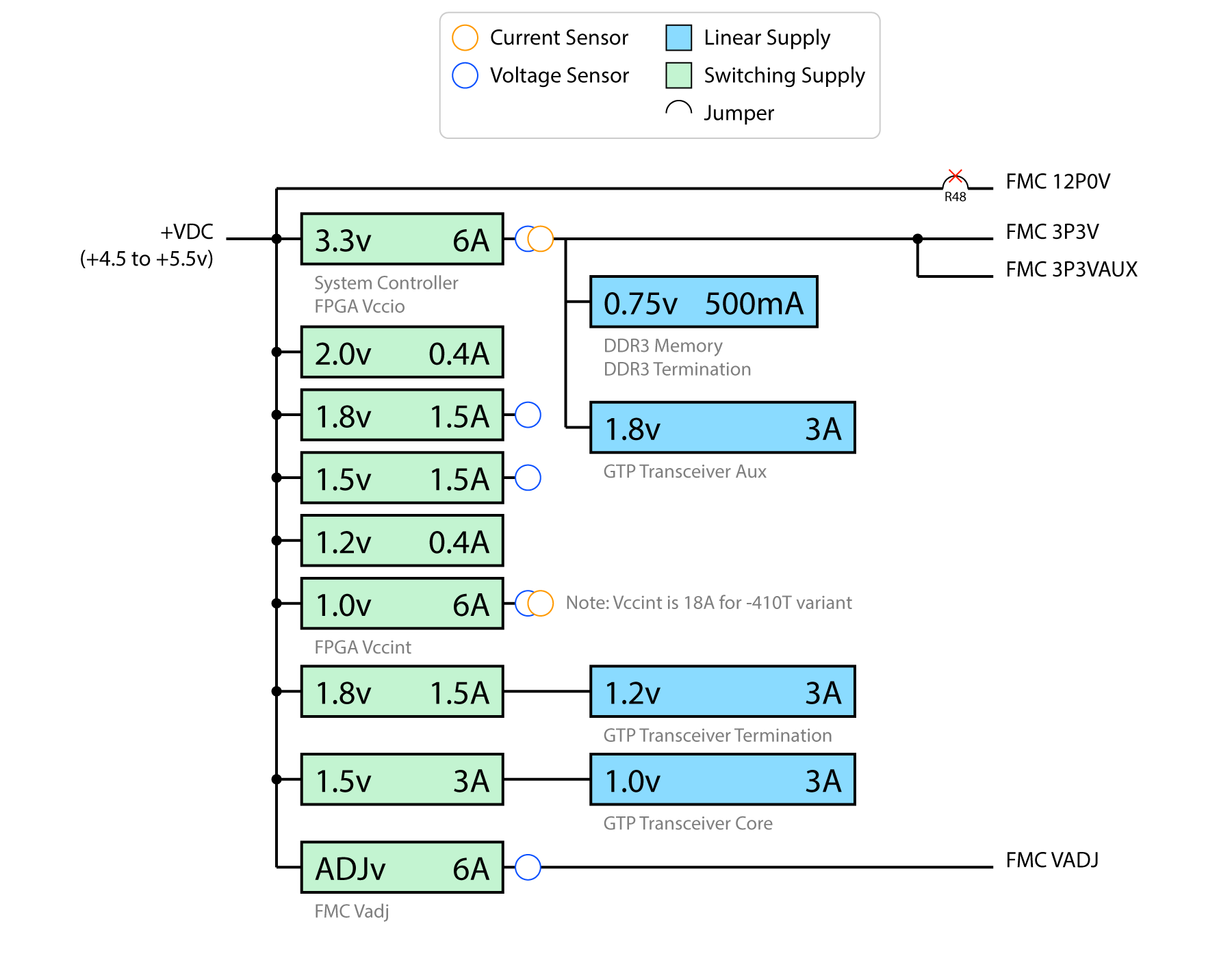Powering the XEM7350
The XEM7350 requires a clean, filtered, DC supply within the range of 4.5v to 5.5v. This supply must be delivered through the DC power connector.
The XEM7350 power distribution system is rather complex, with several supplies designed to provide suitable, efficient power for several systems and modules. A schematic diagram of the system follows, with input (+VDC) shown to the left and accessible supply rails shown to the right.
Note that the XEM7350-K410T has an 15A supply for the 1.0v Vccint. The XEM7350-K70T and XEM7350-K160T both have 6A supplies for this rail.

Power Supply
The XEM7350 is designed to be operated from a single 5-volt power source supplied through the DC power jack on the device. This provides power for the several high-efficiency switching regulators on-board to provide multiple DC voltages for various components on the device as well as an adjustable supply for the FMC peripheral.
DC Power Connector
The DC power connector on the XEM7350 is part number PJ-102AH from CUI, Inc. It is a standard “canon-style” 2.1mm / 5.5mm jack. The outer ring is connected to DGND. The center pin is connected to +VDC.
Powering via USB
The XEM7350 has been designed to accept power (+5VDC only) via the USB connector with a small modification. To power from USB, you will need to install a 0 Ω resistor (0402 dimension) at location R30, located on the reverse side of the PCB under the power connector. This will connect the +5VUSB from the USB connector to the +5VDC on the XEM7350.
With this resistor in place, you should not apply +5VDC to the external power connector.
Power Budget
The table below can help you determine your power budget for each supply rail on the XEM7350. All values are highly dependent on the application, speed, usage, and so on. Entries we have made are based on typical values presented in component datasheets or approximations based on Xilinx power estimator results. Shaded boxes represent unconnected rails to a particular component. Empty boxes represent data that the user must provide based on power estimates.
The user may also need to adjust parameters we have already estimated (such as FPGA Vcco values) where appropriate. All values are shown in milliwatts (mW). Note that this table does not include the two supplies dedicated to the GTX transceivers. These are independent and can be computed separately for power budget based on their assigned function.
| COMPONENT(S) | 1.0V | 1.2V | 1.5V | 1.8V | 2.0V | 3.3V |
|---|---|---|---|---|---|---|
| 200 MHz | 231 | |||||
| USB, DDR3 | 240 | 720 | 250 | |||
| FPGA Vccint, Vccbram | ||||||
| FPGA Vccaux | 355 | |||||
| FPGA Vccaux_io | 120 | |||||
| FPGA Vcco33,34 (DDR3), est. | 273 | |||||
| FPGA Vcco14 (USB), est. | 216 | |||||
| FPGA Vcco | ||||||
| Total (mW) | ||||||
| Available (mW) | 6,000 | 480 | 2,250 | 2,700 | 800 | 19,800 |
Example XEM7350-K160T FPGA Power Consumption
XPower Estimator version 14.3 was used to compute the following power estimates for the Vccint supply. These are simply estimates; your design requirements may vary considerably. The numbers below indicate approximately 80% utilization.
| COMPONENT | PARAMETERS | VCCINT |
|---|---|---|
| Clock | 250 MHz GCLK, 163,237 fanout | 716 mW |
| Logic (DFF) | 250 MHz, 162,240 DFFs | 1,322 mW |
| Logic (LUT) | 250 MHz, 81,120 | 927 mW |
| BRAM | 18-bit, 517 @ 250 MHz | 674 mW |
| DSP | 250 MHz, 480 slices | 605 mW |
| Memory Controller | 1600 Mb/s, DDR3 | 7 mW |
| GTX | Aurora, 8 lanes, 8 Gb/s | 458 mW |
| Misc. | DCM, PLL, etc. | 5 mW |
| Total | 4,714 mW | |
| Available | 6,000 mW |